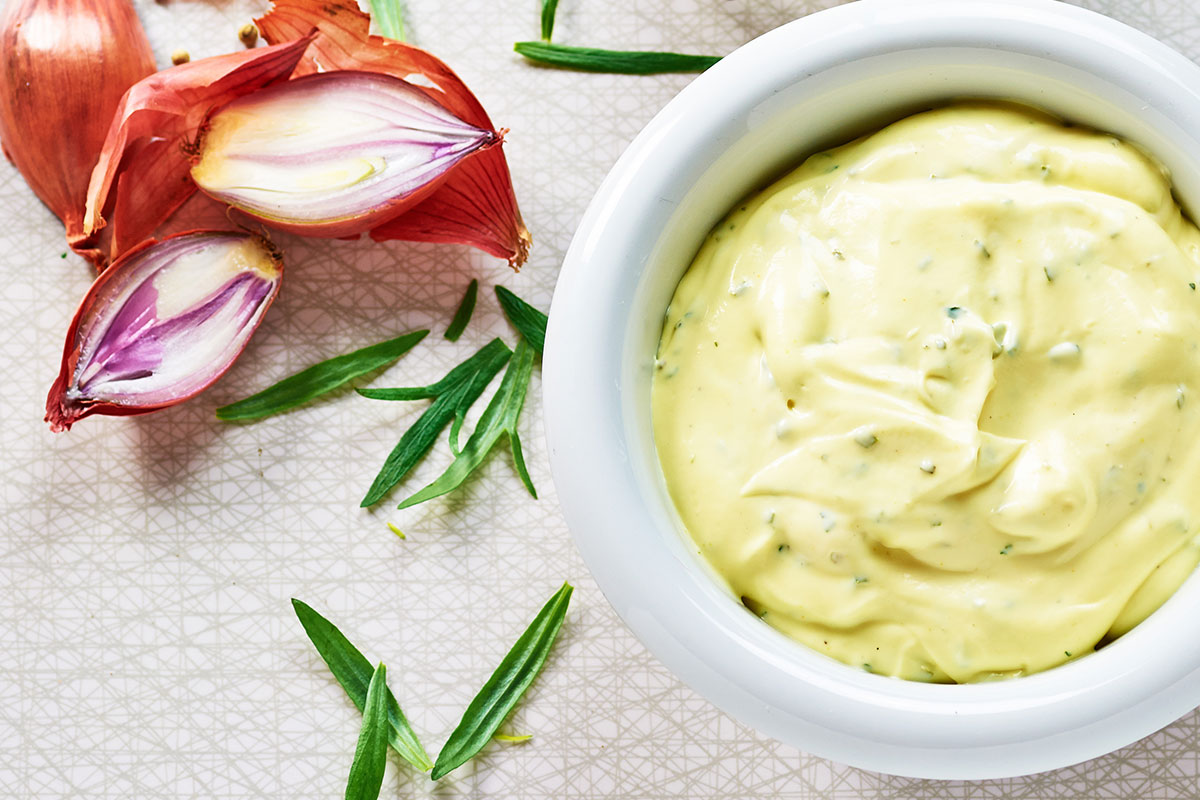Baked Potatoes & Béarnaise Sauce Recipe, Spotlight on Russet Potatoes, How to Prevent Curdled Eggs, Make Informed Choices Based on Salt Content, and Rewrite Your Goals for Greater Success
If you’re like me, you strive to make continual improvements in your well-being but you don’t want to feel deprived. That’s why I love to take favorite recipes and “healthify” them. This béarnaise sauce is the perfect example. By replacing half of the usual amount of butter with extra virgin olive oil, you get all the taste—I’d argue even more!—with the bonus of polyphenols. Another important pro-health step is cutting back on salt—you’ll be surprised at some of the types of packaged foods that researchers named the top culprits when it comes to adding sodium to our daily intake. I’m also sharing advice from a top team of health coaches on how to reframe your wellness goals to make them more attainable.
Baked Potatoes & Béarnaise Sauce
 Baked Potatoes & Béarnaise Sauce
Baked Potatoes & Béarnaise SauceThis rich and flavorful sauce is traditionally an accompaniment for steak, but it’s also a wonderful break from sour cream on a perfectly baked potato—so satisfying it can be the entire meal! Note: Most béarnaise sauce recipes call for making it in a double boiler to avoid curdling the yolks from direct heat—two inches of water are kept at a simmer in the bottom pan while you whisk the ingredients in the top one. However, if you use a low heat and whisk constantly, you can make the sauce in a small saucepan over direct heat.
Ingredients
For the potatoes:
- 4 large russet potatoes
- 1-2 tablespoons extra virgin olive oil, as needed
- A few pinches of coarse salt and twists of freshly ground black pepper
For the béarnaise sauce:
- 1/4 cup sherry vinegar
- 1 shallot, peeled and minced
- 1/2 teaspoon freshly ground black pepper
- 1 tablespoon fresh French tarragon leaves, chopped, or 1 teaspoon dried tarragon, crumbled
- 6 tablespoons unsalted butter
- 6 tablespoons extra virgin olive oil
- 2 egg yolks
- 1 tablespoon water
Directions
Step 1
To bake the potatoes, preheat your oven to 450°F. Line a rimmed baking sheet with a large piece of parchment paper. Scrub and pat dry the potatoes, then place them on the parchment. With the tip of a sharp paring knife, pierce the potatoes on all sides. Rub them all over with olive oil and sprinkle them with salt and pepper. Bake until the tip of the knife easily goes through them, about an hour.
Step 2
About 20 minutes before the potatoes are ready, make the sauce. Place the vinegar, shallots, tarragon, and black pepper in a small saucepan and bring to a boil. Lower the heat and cook until the vinegar is reduced by half. Take the pan off the heat and let the vinegar cool to room temperature, 10 to 15 minutes.
Step 3
Melt the butter and set aside. Whisk the yolks and water into the vinegar reduction and place over low heat. Continue whisking until the mixture thickens and nearly doubles in volume. Then slowly whisk in the butter, about 2 tablespoons at a time; repeat with the olive oil. Continue whisking vigorously until the sauce thickens but is still pourable. If necessary, the sauce can sit for 15 minutes or so; whisk gently before serving as needed.
Step 4
Plate the potatoes and make a large slash lengthwise in each. Top with dollops of the béarnaise sauce and serve the rest on the side.
Yields 4 servings

Healthy Ingredient Spotlight
Russet Potatoes
As much as I love Yukon and red potato varieties, sometimes there’s nothing better than a toothsome russet! When cooked at high heat, these rather large, long, and oval potatoes become fluffy inside and their distinctive thick skin becomes deliciously crispy—eat it up because that’s where so many of its nutrients are. A large potato delivers 5 grams of all-important fiber and healthy doses of potassium, iron, and the vitamins C and B6. Russets are also great cut into even sticks and baked to make oven fries.

Quick Kitchen Nugget
Double Boiler Hack
If you’re nervous about eggs curdling when making sauces or have a testy stovetop whose heat is hard to regulate, it’s easy to create a makeshift double boiler. Just place a metal or glass bowl over a saucepan filled with two inches of water. The bottom of the bowl should not touch the water and the water should be simmering, not boiling.

For Your Best Health
Salt Alert
Health authorities often say it’s the salt in packaged and/or processed foods rather than in your salt shaker that you need to keep track of. Knowing the items with the highest amounts of sodium will help you make better choices when shopping for convenience foods and, in turn, lower your salt intake. That’s important because salt is a risk factor for high blood pressure and cardiovascular disease.
Researchers at the University of Toronto studied over 7,000 research subjects using the 2017–2018 National Health and Nutrition Examination Survey, which consists of information on the health and nutritional status (including dietary recall information on foods consumed) of a nationally representative sample of adults and children in the United States. They identified the top 15 food categories that account for 50.83% of total dietary sodium intake. Some might surprise you and have you rethinking which of your favorite foods you’d be better off making from scratch:
- Pizza: 5.3%
- Breads, rolls, and buns: 4.7%
- Cold cuts and cured meats: 4.6%
- Soups: 4.4%
- Burritos and tacos: 4.3%
- Savory snacks: 4.1%
- Poultry: 4.0%
- Cheese: 3.1%
- Pasta mixed dishes: 2.9%
- Burgers: 2.5%
- Meat mixed dishes: 2.5%
- Cookies, brownies, and cakes: 2.4%
- Bacon, frankfurters, and sausages: 2.4%
- Vegetables: 2.2%
- Chicken nuggets: 1.5%
Said lead author Mavra Ahmed, MSc, PhD, “This data is important in light of the FDA Voluntary Sodium Reduction Goals, which bring renewed focus on the importance of limiting sodium in the food supply and can help focus future efforts.” The research was supported by the Institute for the Advancement of Food and Nutrition Sciences, a science-focused nonprofit.

Fitness Flash
Rewrite Your Goals for Greater Success
According to the experts at Precision Nutrition, an international nutrition coaching and education company that certifies health professionals, we might be setting the wrong fitness goals.
Goals are important—they can help you feel in charge of your life, boost motivation, and encourage actions that lead to change. So what’s the problem? Too often we zero in on the end result rather than the behaviors that will get us there. To switch your focus, the team at Precision Nutrition suggests that, for each finish-line goal you want, you write out the skills or habits that will help get you there and the actions you can take to help build those skills. They outline three distinct types of goals and how to switch them up:
Create behavior goals, not outcome goals. Behavior goals represent your commitment to practice a particular set of actions or tasks every day, as consistently and regularly as possible. Examples of outcome goals are losing 30 pounds or “getting a six-pack.” Examples of behavior goals are eating only until you’re satisfied (rather than stuffed) and taking a Pilates class twice a week.
Create approach goals, not avoidance goals. Avoidance goals, like “don’t eat sugar,” seem straightforward but are counterproductive because telling yourself to stop doing something almost guarantees you’ll keep doing it. Approach goals are steps you take to build a good habit that will naturally replace the one you want to stop. Instead of telling yourself to eliminate all junk food, for instance, prepare healthy snacks, like fruit salad, that will be ready to munch on when hunger strikes and, for motivation, remind yourself of all the nutrients you’ll get as a bonus. If you want to stop stress eating, have a hobby or other stress reliever you can do at a moment’s notice instead.
Create mastery goals, not performance goals. Performance goals, like being able to lift more weight at the gym, can be fleeting. Mastery goals emphasize the process of getting a little bit better each day at a particular skill, and they often result in sustained motivation. So rather than trying to set a personal best at a race, for example, set your focus on running more efficiently and smoothly.
Get More Recipes In Your Inbox!




